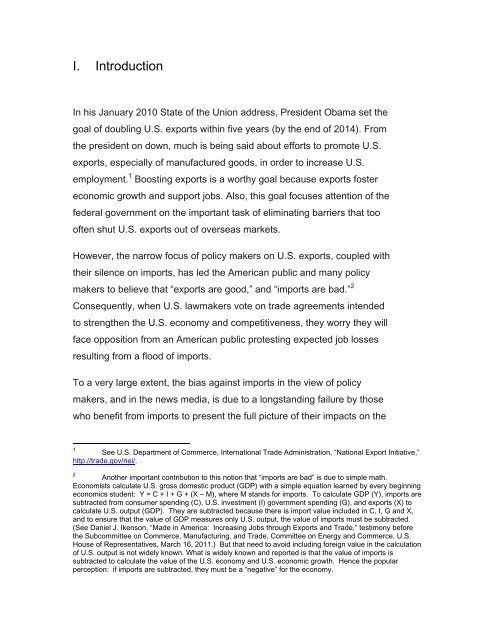You also want an ePaper? Increase the reach of your titles
YUMPU automatically turns print PDFs into web optimized ePapers that Google loves.
I. Introduction<br />
In his January 2010 State of the Union address, President Obama set the<br />
goal of doubling U.S. exports within five years (by the end of 2014). From<br />
the president on down, much is being said about efforts to promote U.S.<br />
exports, especially of manufactured goods, in order to increase U.S.<br />
employment. 1 Boosting exports is a worthy goal because exports foster<br />
economic growth and support jobs. Also, this goal focuses attention of the<br />
federal government on the important task of eliminating barriers that too<br />
often shut U.S. exports out of overseas markets.<br />
However, the narrow focus of policy makers on U.S. exports, coupled with<br />
their silence on imports, has led the American public and many policy<br />
makers to believe that “exports are good,” and “imports are bad.” 2<br />
Consequently, when U.S. lawmakers vote on trade agreements intended<br />
to strengthen the U.S. economy and competitiveness, they worry they will<br />
face opposition from an American public protesting expected job losses<br />
resulting from a flood of imports.<br />
To a very large extent, the bias against imports in the view of policy<br />
makers, and in the news media, is due to a longstanding failure by those<br />
who benefit from imports to present the full picture of their impacts on the<br />
1<br />
See U.S. Department of Commerce, International Trade Administration, “National Export Initiative,”<br />
http://trade.gov/nei/.<br />
2<br />
Another important contribution to this notion that “imports are bad” is due to simple math.<br />
Economists calculate U.S. gross domestic product (GDP) with a simple equation learned by every beginning<br />
economics student: Y = C + I + G + (X – M), where M stands for imports. To calculate GDP (Y), imports are<br />
subtracted from consumer spending (C), U.S. investment (I) government spending (G), and exports (X) to<br />
calculate U.S. output (GDP). They are subtracted because there is import value included in C, I, G and X,<br />
and to ensure that the value of GDP measures only U.S. output, the value of imports must be subtracted.<br />
(See Daniel J. Ikenson, “Made in America: Increasing Jobs through Exports and Trade,” testimony before<br />
the Subcommittee on Commerce, Manufacturing, and Trade, Committee on Energy and Commerce, U.S.<br />
House of Representatives, March 16, 2011.) But that need to avoid including foreign value in the calculation<br />
of U.S. output is not widely known. What is widely known and reported is that the value of imports is<br />
subtracted to calculate the value of the U.S. economy and U.S. economic growth. Hence the popular<br />
perception: if imports are subtracted, they must be a “negative” for the economy.


